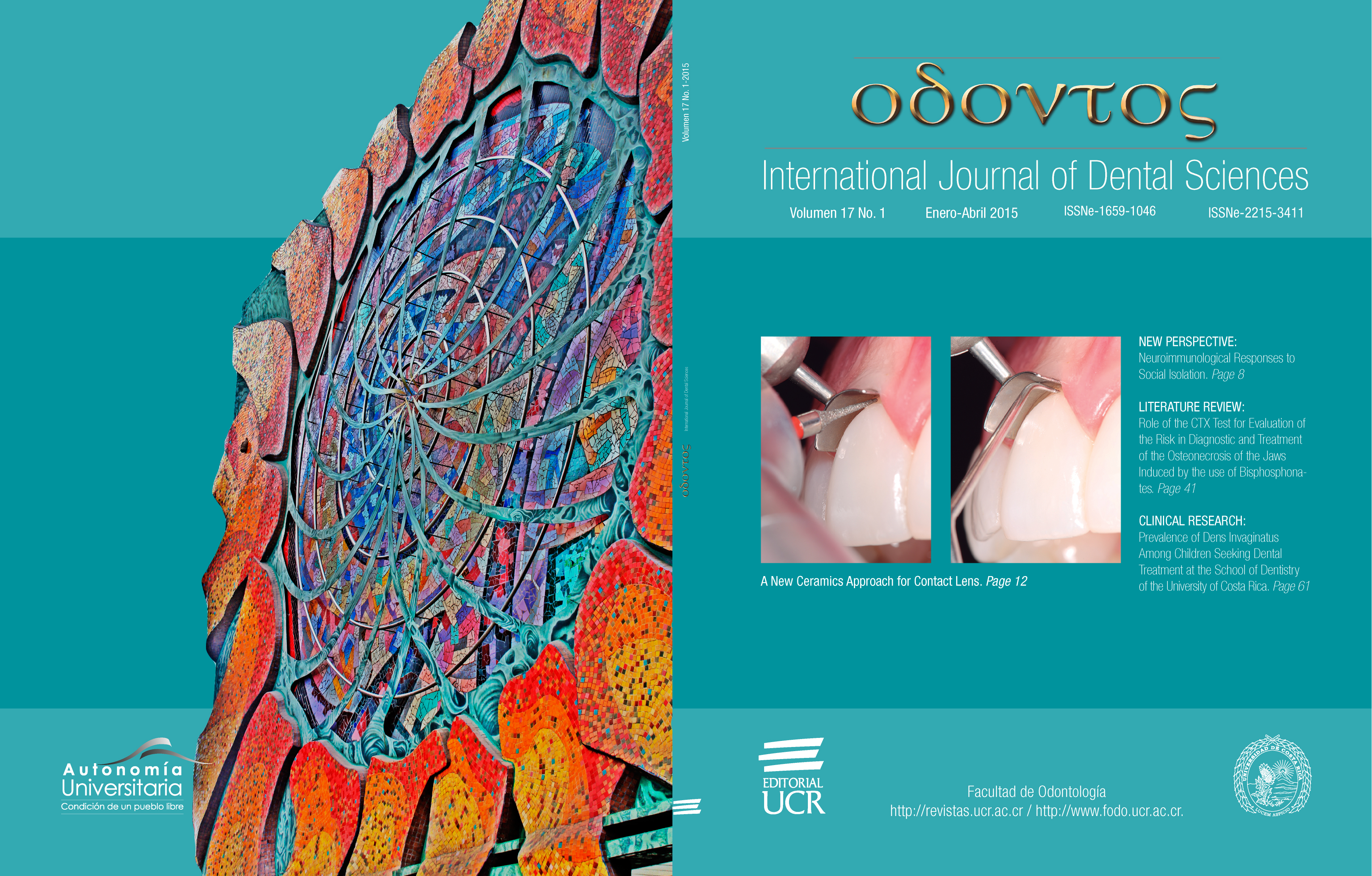Resumen
Se realizó una revisión bibliográfica con el fin de conocer la efectividad de la prueba del telopéptido C terminal de reticulación (CTX), la cual ha sido sugerida para predecir el grado de riesgo a padecer osteonecrosis de los maxilares en pacientes que consumen o consumieron bifosfonatos orales. La osteonecrosis de lo maxilares (OMIB) es una condición ósea que provoca necrosis avascular del hueso alveolar y que se da en pacientes que están bajo tratamiento con bifosfonatos. Se ha sugerido que un valor de CTX por debajo de los 100pg/ml representa un riesgo alto de padecer OMIB, mientras que entre los 100 y los 150 pg/ml un riesgo moderado y por encima de los 150pg/ml un riesgo mínimo. La prueba CTX ha sido debatida, y no ha sido posible enmarcarla como prueba contundente, ya que diversos estudios han encontrado resultados muy variables, en pacientes que con CTX muy bajos no han desarrollado OMIB y otros que si lo han hecho con valores de CTX muy altos, supuestamente seguros. Conclusión: La prueba CTX es una prueba útil para informar al odontólogo acerca del grado de actividad en el recambio óseo del paciente, y puede ser útil para aconsejar al paciente. Niveles bajos de CTX podrían servir para aplazar un procedimiento quirúrgico que no se considere urgente. Se recomienda aumentar a 200 pg/ml la línea de riesgo quirúrgico en relación a los 150 pg/ml recomendados por Marx.
Citas
Marx R., Cillo J. Jr , Ulloa JJ. Oral bisphosphonate-induced osteonecrosis: risk factors, prediction of risk using serum CTX testing, prevention, and treatment. Journal of Oral and Maxillofacial Surgery, Dec 2007; 65(12): 2397-2410.
Marx R.E., Sawatari Y, Fortin M, Broumand V. Bisphosphonate-induced exposed bone (osteonecrosis/ osteopetrosis) of the jaws: Risk factors, recognition, prevention, and treatment. Journal of Oral and Maxillofacial Surgery, 2005; 63, 1567.
Assael LA. Serum CTX to prevent osteonecrosis/orthodontic extraction of third molars: paths toward minimizing surgical risk?. Journal of Oral and Maxillofacial Surgery, (Dec-2007;65(12): 2395-2396.
O'Connell J.E., Ikeagwani O, Kearns G.J. A role for C-terminal cross-linking telopeptide (CTX) level to predict the development of bisphosphonate-related osteonecrosis of the jaws (BRONJ) following oral surgery?. Irish Journal of Medical Science, Jun-2012; 181(2): 237-242.
Pasoff M. C-Terminal Cross-Linking Telopeptide as a Serologic Marker for Bisphosphonate-Related Osteonecrosis of the Jaw: Review of 2 Cases. Journal of the Canadian Dental Association, (2013). 1-11.
Sawatari Y., Marx R. E. Bisphosphonates and Bisphosphonate Induced Osteonecrosis. Oral Maxillofacial, Surgical Clinics of North America Journal, 2007; 19: 487–498.
Lazarovici T.S, Mesilaty-Gross S., Vered I., Pariente C., Kanety H., Givol N,. Yahalom R., Taicher S., Yarom N. Serologic bone markers for predicting development of osteonecrosis of the jaw in patients receiving bisphosphonates. Journal of Oral and Maxillofacial Surgery, Sep-2010;68(9): 2241-2247.
Lee C.Y, Suzuki J.B. CTX biochemical marker of bone metabolism. Is it a reliable predictor of bisphosphonate-associated osteonecrosis of the jaws after surgery? Part I: biological concepts with a review of the literature. Implant Dentistry, Dec-2009;18(6): 492-500.
Kunchur R, Need A, Hughes T, Goss A. Clinical investigation of C-terminal cross-linking telopeptide test in prevention and management of bisphosphonate-associated osteonecrosis of the jaws. Journal of Oral and Maxillofacial Surgery, Jun-2009; 67(6): 1167-1173.
Ruggiero S.L., Dodson T.B., Assael L.A., Landesberg R, Marx R.E., Mebrotra B. American Association of Oral and Maxillofacial Surgeons position paper on bisphosphonate- related osteonecrosis of the jaws. Journal of Oral and Maxillofacial Surgery, 2009; 67, 2.
Borromeo G.L, C.E Tsao, I.B Darby, P.R Ebeling. A review of the clinical implications of bisphosphonates in dentistry. Australian Dental Journal, 2011; 56: 2–9.
Mavrokokki T, Cheng A, Stein B, Goss A. Nature and frequency of bisphosphonate-associated osteonecrosis of the jaws in Australia. Journal of Oral and Maxillofacial Surgery, 2007; 65: 415-423.
Dodson T.B. CTX and its role in managing patients exposed to oral bisphosphonates. Journal of Oral and Maxillofacial Surgery, Feb-2010; 68(2): 487-488.
Khosla S, Burr D, Cauley J, Dempster D.W, Ebeling P, Felsenberg D, Gagel R. Oral bisphosphonate-induced osteonecrosis: Risk factors, prediction of risk using serum CTX testing, prevention, and treatment. American Society for Bone and Mineral Research Task Force on Osteonecrosis of the jaw. Journal of Oral and Maxillofacial Surgery, (2008); 66, 1320.
Reynag B., Zeni S. Marcadores bioquímicos del remodelamiento óseo. Utilidad clínica Acta Bioquímica Clínica Latinoamericana, Abril-Junio 2009; 43 (2): 177-193.
Cons F. Marcadores Bioquímicos de Remodelado Óseo. Revista de Metabolismo Oseo y Mineral, 2003;1(3): 91-98.
Schwartz H.C. Serum CTX testing. Journal of Oral and Maxillofacial Surgery, Jun-2008; 66(6): 1319-1320.
Bagan J.V., Jiménez Y., Gómez D., Sirera R., Poveda R., Scully C. Collagen telopeptide (serum CTX) and its relationship with the size and number of lesions in osteonecrosis of the jaws in cancer patients on intravenous bisphosphonates. Oral Oncology, Nov 2008; 44(11).
Kwon Y., Kim D., Ohe J., Yoo J., Walter C. Correlation between serum C-terminal cross-linking telopeptide of type I collagen and staging of oral bisphosphonate-related osteonecrosis of the jaws. Journal of Oral and Maxillofacial Surgery, Dec- 2009; 67(12): 2644-2648.
Lazarovici T.S., Yahalom R., Taicher S., Elad S., Hardan I., Yarom N. Bisphosphonate-related osteonecrosis of the jaws: A single-center study of 101 patients. Journal of Oral and Maxillofacial Surgery, 2009;67: 850-855.
Lee C.Y. CTX biochemical marker of bone metabolism. Is it a reliable predictor of bisphosphonate-associated osteonecrosis of the jaws after surgery? Part II: a prospective clinical study. Implant Dentistry, Feb-2010;19(1): 29-38.
Avolio G., Brandão C., Marcucci M., Alonso G. Use of the plasma CTX for assessing the bone activity of the mandible among osteopenic and osteoporotic patients. Brazillian Oral Research, 2010; 24(2): 250-255.

